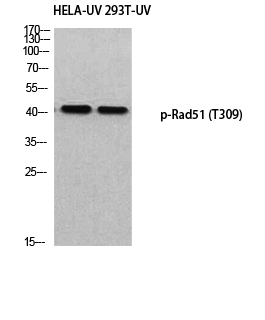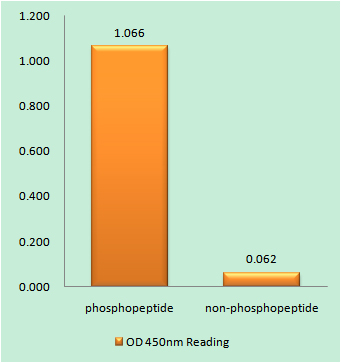
主要信息
Target
RAD51
Host Species
Rabbit
Reactivity
Human, Mouse
Applications
WB, IHC, IF, ELISA
MW
37kD (Observed)
Conjugate/Modification
Phospho
货号: YP0376
规格
价格
货期
数量
200μL
¥4,680.00
现货
0
100μL
¥2,800.00
现货
0
50μL
¥1,500.00
现货
0
加入购物车


已收藏


收藏
详细信息
推荐稀释比
WB 1:500-1:2000; IHC 1:100-1:300; ELISA 1:10000; IF 1:50-200
组成
Liquid in PBS containing 50% glycerol, 0.5% BSA and 0.02% sodium azide.
特异性
Phospho-Rad51 (Y315) Polyclonal Antibody detects endogenous levels of Rad51 protein only when phosphorylated at Y315.The name of modified sites may be influenced by many factors, such as species (the modified site was not originally found in human samples) and the change of protein sequence (the previous protein sequence is incomplete, and the protein sequence may be prolonged with the development of protein sequencing technology). When naming, we will use the "numbers" in historical reference to keep the sites consistent with the reports. The antibody binds to the following modification sequence (lowercase letters are modification sites):KIyDS
纯化工艺
The antibody was affinity-purified from rabbit antiserum by affinity-chromatography using epitope-specific immunogen.
储存
-15°C to -25°C/1 year(Do not lower than -25°C)
浓度
1 mg/ml
实测条带
37kD
修饰
Phospho
克隆性
Polyclonal
同种型
IgG
相关产品
抗原&靶点信息
免疫原:
The antiserum was produced against synthesized peptide derived from human RAD51 around the phosphorylation site of Tyr315. AA range:281-330
展开内容
特异性:
Phospho-Rad51 (Y315) Polyclonal Antibody detects endogenous levels of Rad51 protein only when phosphorylated at Y315.The name of modified sites may be influenced by many factors, such as species (the modified site was not originally found in human samples) and the change of protein sequence (the previous protein sequence is incomplete, and the protein sequence may be prolonged with the development of protein sequencing technology). When naming, we will use the "numbers" in historical reference to keep the sites consistent with the reports. The antibody binds to the following modification sequence (lowercase letters are modification sites):KIyDS
展开内容
基因名称:
RAD51
展开内容
蛋白名称:
DNA repair protein RAD51 homolog 1
展开内容
别名:
RAD51 ;
RAD51A ;
RECA ;
DNA repair protein RAD51 homolog 1 ;
HsRAD51 ;
hRAD51 ;
RAD51 homolog A
RAD51A ;
RECA ;
DNA repair protein RAD51 homolog 1 ;
HsRAD51 ;
hRAD51 ;
RAD51 homolog A
展开内容
背景:
The protein encoded by this gene is a member of the RAD51 protein family. RAD51 family members are highly similar to bacterial RecA and Saccharomyces cerevisiae Rad51, and are known to be involved in the homologous recombination and repair of DNA. This protein can interact with the ssDNA-binding protein RPA and RAD52, and it is thought to play roles in homologous pairing and strand transfer of DNA. This protein is also found to interact with BRCA1 and BRCA2, which may be important for the cellular response to DNA damage. BRCA2 is shown to regulate both the intracellular localization and DNA-binding ability of this protein. Loss of these controls following BRCA2 inactivation may be a key event leading to genomic instability and tumorigenesis. Multiple transcript variants encoding different isoforms have been found for this gene. [provided by RefSeq, Aug 2009],
展开内容
功能:
Disease:Defects in RAD51 are associated with breast cancer (BC) [MIM:114480].,Function:May participate in a common DNA damage response pathway associated with the activation of homologous recombination and double-strand break repair. Binds to single and double stranded DNA and exhibits DNA-dependent ATPase activity. Underwinds duplex DNA and forms helical nucleoprotein filaments.,PTM:Phosphorylated. Phosphorylation of Thr-309 by CHEK1/CHK1 may enhance association with chromatin at sites of DNA damage and promote DNA repair by homologous recombination.,similarity:Belongs to the recA family.,similarity:Belongs to the recA family. RAD51 subfamily.,similarity:Contains 1 HhH domain.,subcellular location:Colocalizes with RAD51AP1 to multiple nuclear foci upon induction of DNA damage.,subunit:Interacts with BRCA1, BRCA2 and either directly or indirectly with p53. Interacts with XRCC3, RAD54L and RAD54B. Part of a complex with RAD51C and RAD51B. Interacts with RAD51AP1 and RAD51AP2. Interacts with CHEK1/CHK1, and this may require prior phosphorylation of CHEK1. Interacts with the MND1-PSMC3IP heterodimer (By similarity). Interacts with OBFC2B.,tissue specificity:Highly expressed in testis and thymus, followed by small intestine, placenta, colon, pancreas and ovary. Weakly expressed in breast.,
展开内容
细胞定位:
Nucleus . Cytoplasm . Cytoplasm, perinuclear region. Mitochondrion matrix . Chromosome . Cytoplasm, cytoskeleton, microtubule organizing center, centrosome . Colocalizes with RAD51AP1 and RPA2 to multiple nuclear foci upon induction of DNA damage (PubMed:20154705). DNA damage induces an increase in nuclear levels (PubMed:20154705). Together with FIGNL1, redistributed in discrete nuclear DNA damage-induced foci after ionizing radiation (IR) or camptothecin (CPT) treatment (PubMed:23754376). Accumulated at sites of DNA damage in a SPIDR-dependent manner (PubMed:23509288). Recruited at sites of DNA damage in a MCM9-MCM8-dependent manner (PubMed:23401855). Colocalizes with ERCC5/XPG to nuclear foci in S phase (PubMed:26833090). .
展开内容
组织表达:
Highly expressed in testis and thymus, followed by small intestine, placenta, colon, pancreas and ovary. Weakly expressed in breast.
展开内容
研究领域:
>>Homologous recombination ;
>>Fanconi anemia pathway ;
>>Pathways in cancer ;
>>Pancreatic cancer
>>Fanconi anemia pathway ;
>>Pathways in cancer ;
>>Pancreatic cancer
展开内容
信号通路
文献引用({{totalcount}})
货号: YP0376
规格
价格
货期
数量
200μL
¥4,680.00
现货
0
100μL
¥2,800.00
现货
0
50μL
¥1,500.00
现货
0
加入购物车


已收藏


收藏
Recently Viewed Products
Clear allToggle night Mode
{{pinfoXq.title || ''}}
Catalog: {{pinfoXq.catalog || ''}}
Filter:
All
{{item.name}}
{{pinfo.title}}
-{{pinfo.catalog}}
主要信息
Target
{{pinfo.target}}
Reactivity
{{pinfo.react}}
Applications
{{pinfo.applicat}}
Conjugate/Modification
{{pinfo.coupling}}/{{pinfo.modific}}
MW (kDa)
{{pinfo.mwcalc}}
Host Species
{{pinfo.hostspec}}
Isotype
{{pinfo.isotype}}
产品 {{index}}/{{pcount}}
上一个产品
下一个产品
{{pvTitle}}
滚轮缩放图片
{{pvDescr}}





















